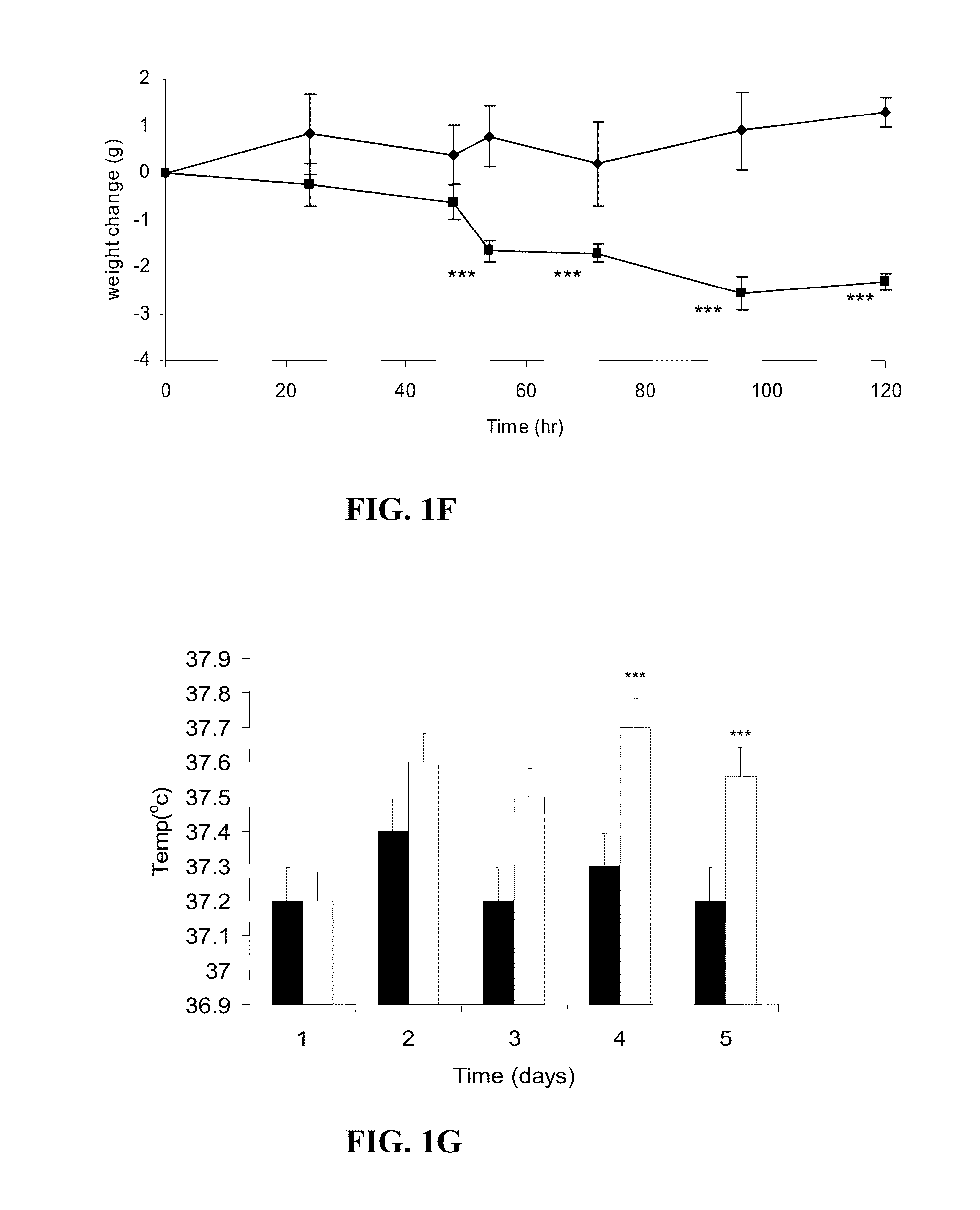Glycoproteins having lipid mobilizing properties and therapeutic uses thereof
a technology of glycoproteins and lipids, applied in the field of hyperglycemia and obesity medicine, can solve the problems of muscle wasting caused by insulin resistance, and achieve the effect of improving the symptoms associated with hyperglycemia and reducing the amount of insulin in the body
- Summary
- Abstract
- Description
- Claims
- Application Information
AI Technical Summary
Benefits of technology
Problems solved by technology
Method used
Image
Examples
example 1
Zinc-α2-Glycoprotein Attenuates Hyperglycemia
[0124]To evaluate the ability of Zinc-α2-glycoprotein (ZAG) to attenuate obesity and hyperglycemia ob / ob mice were administered ZAG which induced a loss of body weight, and a rise in body temperature, suggesting an increased energy expenditure. Expression of uncoupling proteins-1 and -3 in brown adipose tissue were increased, while there was a decrease in serum levels of glucose, triglycerides and non-esterified fatty acids, despite an increase in glycerol, indicative of increased lipolysis. There was a decrease in plasma insulin and an improved response to intravenous glucose together with an increased glucose uptake into adipocytes and skeletal muscle. Expression of hormone-sensitive lipase in epididymal adipocytes was increased. There was an increase in skeletal muscle mass due to an increase in protein synthesis and decrease in degradation. This suggests that ZAG may be effective in the treatment of hyperglycemia.
[0125]Dulbeccos' Modi...
example 2
Interval Administration of Zinc-α2-Glycoprotein
[0172]It was observed that long-term daily administration of ZAG in ob / ob mice results in a cessation of weight loss. As such, it was determined that a break of 3-4 days followed by re-infusion ZAG resulted in continued weight loss and amelioration of the symptoms associated with hyperglycemia.
[0173]While not wanting to be limited by theory, it may be that the subjects are receiving too much ZAG or that there is receptor desensitization as is seen with TNF. A pilot study was performed with 2 mice in each group to determine optimal scheduling of ZAG delivery. An 8-10 g weight loss from a 90 g mouse was observed in about 3 weeks.
[0174]Adipocytes were removed from mice after 5 days of ZAG and their responsiveness to isoprenaline (iso) was measured after culture in the absence of ZAG (FIG. 9). The responsiveness to iso is higher in ZAG treated mice and this continues for a further 4 days (which was when expression of ZAG and HSL were increa...
example 3
Zinc-α2-Glycoprotein Attenuates Muscle Atrophy in Ob / Ob Mouse
[0175]This example demonstrates the mechanism by which ZAG attenuates muscle atrophy in the ob / ob mouse using a newly developed in vitro model (Russell et al, Exp. Cell Res. 315, 16-25, 2009). This utilizes murine myotubes subjected to high concentrations of glucose (10 or 25 mM). As shown in FIG. 18 high glucose stimulates an increase in protein degradation (FIG. 18A), and depresses protein synthesis (FIG. 18B), and both of these effects were completely attenuated by ZAG (25 μg / ml). It was therefore determined if the effect of ZAG was mediated through β3-AR using the antagonist SR59230A. However the SR compound (i.e., SR59230A) can also act as a β-agonist, which it seemed to do in these experiments. Thus protein degradation induced by both 10 and 25 mM glucose was attenuated by both ZAG and the SR compound, and the combination was additive rather than antagonistic (FIG. 19). For protein synthesis (FIG. 20) the SR compound...
PUM
 Login to View More
Login to View More Abstract
Description
Claims
Application Information
 Login to View More
Login to View More - R&D
- Intellectual Property
- Life Sciences
- Materials
- Tech Scout
- Unparalleled Data Quality
- Higher Quality Content
- 60% Fewer Hallucinations
Browse by: Latest US Patents, China's latest patents, Technical Efficacy Thesaurus, Application Domain, Technology Topic, Popular Technical Reports.
© 2025 PatSnap. All rights reserved.Legal|Privacy policy|Modern Slavery Act Transparency Statement|Sitemap|About US| Contact US: help@patsnap.com



